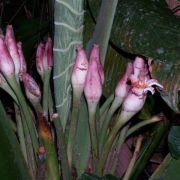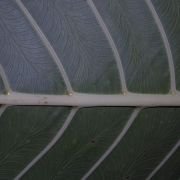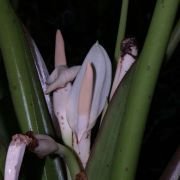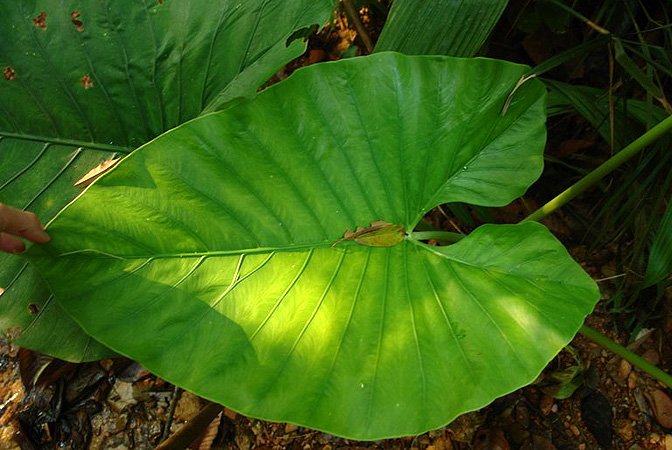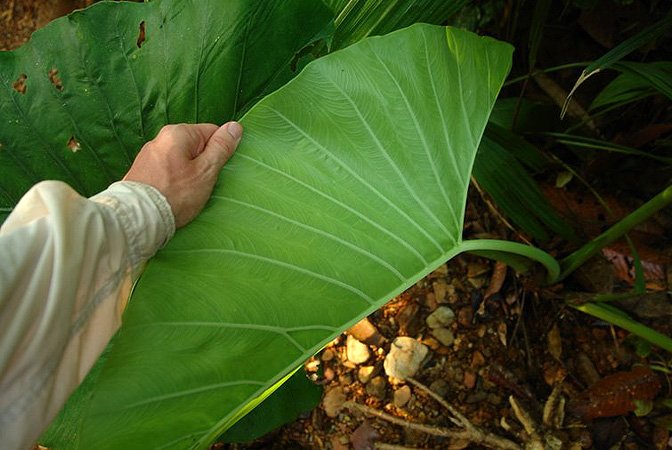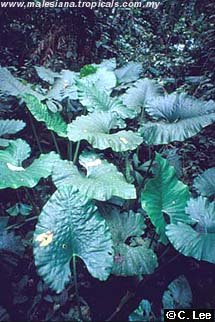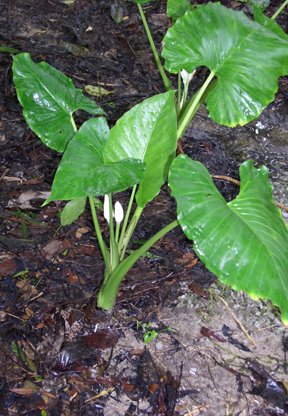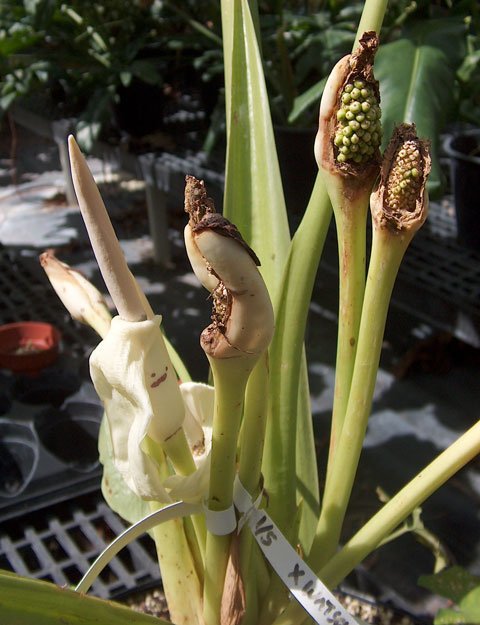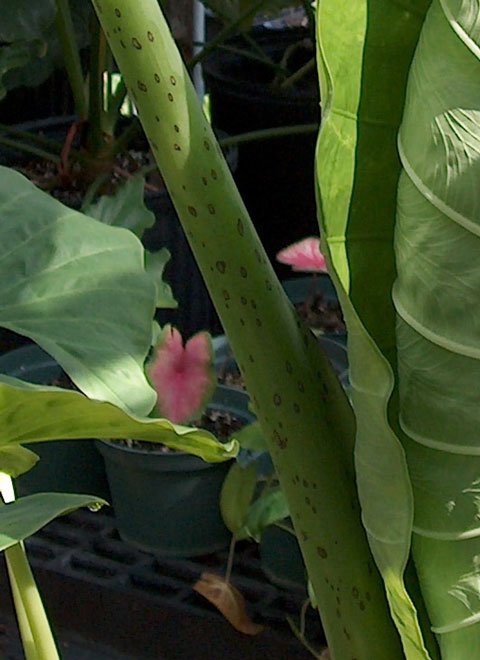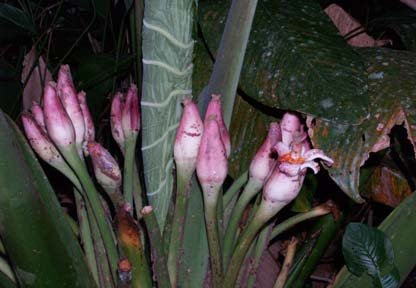ALOCASIA SARAWAKENSIS
ORIGINAL DESCRIPTION:
Caudex validus ca. 50 cm altus, 15 cm crassus, erectus. Foliorum petiolus viridis, sursum attenuatus, 140-150 cm longus, apice 2cm crassus, basi late vaginatus, vagina ca. 45 cm longa; lamina ampla, herbaceo-coriacea, viridis, late ovato-sagittata, 80 cm longa, 60 cm lata; lobus anticus ovatus, apice acutus, nervis lateralibus I. utrinque ca. 13 a costa patentibus, costis anticis inferne digitum crassis sursum attenuatis; lobus posticus ovatus, apiee rotundatus, costis posticisangulo ebtuso distantibus,in sinu 3 cm longo denudatis, nervis laterilibus I. latere interiore 3-5, latere exteriore 4-5. Pedunculus crassus, 30-35 cm longus. Spathae tubus cylindrico-ovoideus, albus, atropurpureo vittatus, 5 cm longus, 2.2 cm latus, lamina flavescens, elongato-ovata, recuvata, 9 cm longa, 3.5 cm lata. Spadicis pars feminea 2 cm longa, pars mascula sterilis inferna! cm longa,pars mascula fertiliscylindrica 3cm Ionga, pars mascula sterilis superna (appendix)elongato-conoidea 6.5cm longa, 1.3cm lata,apice acuta. Pistillaglobosoobvoidea, albida, crebro albopunctata, 2 mm longa et lata,stylo elongato, 1.5mm longo; stigmate subgloboso, flavo, 1 mm lato; ovulis 5-6. Synandroidea 2 mm longa. Synandria 4-6 andra, 2mn longa
SYNONYMS: N/A
DISTRIBUTION: Indonesia, Borneo, Sabah and Sarawak: with one doubtful record from Kalimantan.
CLIMATE: Tropical humid climate
Humidity is moderate throughout the year, ranging from 60% to 70%
Temperature is varies between the seasons - within the range of 48°F/9°C to 88°F/31°C during the day. Minimum temperatures never dip below 45°F/7°C
Rainy and humid season (October to May) and a dry season between June and October. The average annual rainfall is 1,200 mm
ECOLOGY: Moist limestone gravelly slope in dense forest. Common in open swampy places; often seen in roadside ditches; encountered in swampy places in forest as a hairy juvenile; from sea level to ca. 1200 m altitude
SPECIES DESCRIPTION:
Massive arborescent herb; stem more or less erect, to ca. 15 cm diam., to 70 cm tall; leaves several together with the blades erect to oblique; petiole to 130 cm long, sheathing in the lower 1/3-2/5, pale dull green, very slightly rough, with numerous glands mainly in the sheathing portion, these ellipsoid, ca. 4 mm long, ahgned along the axis of the petiole, red at first, later turning yellow, in juveniles often ringed with blackish purple; blades somewhat glossy mid-green above, paler below, glabrous in adult plants, abaxially hairy in juveniles, cordato-sagittate, ca. 90 cm x 80 cm; anterior lobe ca. 60 cm long, with the margins slightly undulate; posterior lobes ca. 35 cm long, rounded, held somewhat above the plane of the anterior lobe; posterior costae diverging at ca. 80-90°, naked in the sinus for ca. 2 cm; primary lateral veins 10-12 on each side of the anterior costa diverging at ca. 45°, their distal portions often emitting subsidiary veins, especially on side facing posterior lobes; secondary veins forming very well-defined interprimary collective veins; costae and primary veins whitish abaxially, green adaxially; primary and secondary venation very prominent abaxially, more or less flush adaxially; glands conspicuous in axils of primary veins and very large at junction of petiole with costae, yellowish green
INFLORESCENCE:
Inflorescences very numerous, to ca. 40 crowded in the centre of the leaf crown from within which the relay axis eventually appears, paired and subtended by somewhat persistent (thence marcescent-deliquescent) ca. 30 cm long lanceolate cataphylls bearing glands; peduncles ca. 30-40 cm long, mostly hidden within the cataphylls, with a few scattered glands, pale dull green, ca. 2 cm diam.; spathe ca. 19 cm long; lower spathe 7 cm x 2.5 cm and somewhat flattened, white with a basal ring of confluent glands, these at first shiny white, becoming purple, the remainder of the lower spathe with scattered ellipsoid glands aligned transverse to the long axis of the spathe and somewhat clustered at about 2/3 of the way up the lower spathe: spathe limb white, to 12 cm long, erect at female anthesis, then sharply reflexed and rolled back at male anthesis, broadly lanceolate, to 5 cm wide, horizontally wrinkled abaxially; spadix to ca. 16 cm long, stipitate for ca. 5 mm, stipe white; female zone 2.5 cm long ca. 1.5 cm wide at base, distally somewhat tapering; ovaries whitish ivory, sub-globose, ca. 1.5 mm diam; style very slender, ca. 1 mm long; stigma abruptly wider than style, ± rounded and inconspicuously 2-3-lobed, like the style, ivory; sterile interstice ca. 1 X 1 cm, hardly attenuate; synandrodia flat-topped, ivory, rhomboid, ca. 3 mm long; male zone 3 cm x 1 cm, partly within the lower spathe chamber; synandria + hexagonal, opening by apical pores not overtopped by synconnective, 6-8-merous, ivory; appendix apricot coloured, 9 cm long, 1.5 cm diam., tapering to a point, the surface covered with horizontally elongate, sinuous staminodes; /rw/r/ng spathe white, dehiscing longitudinally; fruits red.
VARIEGATED FORMS: N/A
ETYMOLOGY: The species is named simply after the geographical location where it was first encountered, Sarawak, on the island of Borneo, in Malaysia
NOTES:
1. This species is easily distinguished from Alocasia robusta and Alocasia macrorrhizos, which sometimes all occur together and resemble each other in the very large broad leaves and preference for open habitats, by the very prominent venation on the abaxial side of the leaf blade, forming well defined interprimary collective veins. It can be distinguished further from Alocasia robusta by having the posterior costae naked in the sinus and the abaxial side of the lamina not glaucous. However, occasional specimens are intermediate (e.g. Agama & Valera 9887): they suggest that some hybridization may take place where the two species occur together
2. Alocasia sarawakensis is far more common that the meager number of herbarium collections would suggest, perhaps because it (and Alocasia robusta) is mistaken for Alocasia macrorrhizos and threrefore not considered worth collecting. Aside from the leaf venation characteristics, it is amply distinguished from Alocasia macrorrhizos by the basically white spathe with red markings, and by the arrangement of the inflorescences in a large central cluster, where the spathe of Alocasia macrorrhizos is green and yellow, and the inflorescence pairs are interspersed with foliage leaves. Moreover, while Alocasia sarawakensis (and Alocasia robusta) are found widely in disturbed places, Alocasia macrorrhizos is hardly ever encountered more than a short distance from human habitation, suggesting that it is not a native Bornean plant at all, while Alocasia sarawakensis and Alocasia robusta are Bornean endemics (the latter also in the Natuna Islands).
3. Alocasia crassinervia Engl (not an accepted species) was described from a seedling cultivated at Bogor, said to have been from Borneo. The type consists of a single early juvenile pubescent leaf, which could be from Alocasia sarawakensis. However, it could equally be a juvenile of Alocasia puber, which grows in the vicinity of Bogor. In the event that it could be demonstrated clearly that the type of Alocasia crassinervia is of the Bornean species, I would recommend conserving the name Alocasia sarawakensis.
4. I (A. Hay) have not seen the Bornean specimens determined by Hotta (loc. cit.) as Alocasia puber {Hotta 14175 and 14231), but it seems highly probable that these hairy sterile plants are juveniles of Alocasia sarawakensis. The only collection of this species from Kalimantan (Barley et al. 596) is identified with some doubt, as the usually characteristic persistent horizontal glands on the lower spathe appear to be lacking. The specimen is in fruit. The leaf matches this species more than any other known Bornean element.
Other specimens seen: SABAH: Semporna, Timbun Mata F.R., Agama & Valera 9887 (K, SING); Kinabatangan Besar, Kori Timber Camp, Cuadra A2144 (all seedlings: BO, KEP mixed - see also A. robusta, K, L, SING); Sepilok, Forest Research Centre grounds, Hay 10010 (SAN, spirit only); Lahad Datu Rd, ca. 10 mi ex jnct Sandakan-Kota Kinabalu Rd, Hay 10013 (SAN); Cult. RBG Sydney Acc. No. 950366 ex Ulu Dusun, Hay 10029 (NSW); Cult. RBG Sydney Acc. No. 950374, Madai Falls, Hay 10037 (NSW); Cult. RBG Sydney Acc. No. 960547 ex Tibau Forest Station, Kinabatangan, Hay 12138 (NSW); Cult. RBG Sydney Acc. No. 960577 ex 2.5 km above Maliau Falls, G. Rara F.R., Hay 12056 (NSW); Cult. RBG Sydney Acc. No. 960597 ex Kinabatangan, Kalabakan Virgin Jungle Reserve, Hay 12017 (NSW); Semporna, Timpun Mata F.R., Mapat R., Keith BNB 7419 (A, KEP, K, L). KALIMANTAN: Headwaters of Sg. Kahayan, 5km N.E. of Haruwu Vill., Biirley et al. 596 (KEP, K, SING).
CULTIVARS: N/A
HYBRIDS: N/A
An illustration of four species and cultivars that are often mislabeled with each other: Alocasia sarawakensis, Alocasia ‘Yucatan Princess’, Alocasia macrorrhizos ‘Plumbea’, and Alocasia ‘Serendipity’




